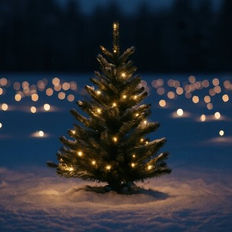

Oct 281 min read


Jan 22 min read
We're looking out for native flowers all year long. Dozens of native species are in bloom now and many may be good additions to your yard to support pollinators. Click through the slideshow to view.




Dark Sky Friendly Holiday Lights
Nov 2025
Many people string up outdoor lights for the holiday season. Bringing light to your home can be an important part of the winter holidays, celebrating light and warmth in the longest nights of the year. Although the majority of holiday lights are dimmer and on the warmer spectrum, a 2014 NASA study did find a 20-50% in light pollution during the holiday season. For tips on how to help preserve dark skies this holiday season, check out our latest blog to the right.
Town-Wide Yard and Native Plant Sale a Huge Success
October 2025
The weather was spectacular for our 3rd Town-Wide Yard and Native Plant Sale, and we have much to be grateful for. It was perfect weather to seek needed items and explore hidden treasures while meeting new folks and catching up with friends and neighbors.
Thanks to all who shopped local, recycled, reused, and supported native plants and biodiversity! A special thanks to all those that help to organize, advertise, donated plants and hosted yard sale. We raised over $2k this year, and these funds will allow WN2 to continue improving the 3 Native Demonstration Gardens in Town (Pipestaves, GAR library, and Cherry Hill Reservoir), maintain our website, and fund educational programs on native plants, invasive control, pollinators, wildlife, and dark skies. We loved meeting so many native plant enthusiasts at the sale and are especially grateful to the number of native plants that are now being planted in West Newbury and surrounding communities.
LEAVE AND STEMS FOR POLLINATORS
October 2025
This fall, instead of raking and baggings leaves for the landfill, consider leaving the leaves. Raked under trees, shrubs, and onto garden beds, leaves are free mulch to suppress weeds, keep your soil moist and will fertilize your plants as it breaks down next year. Many wildlife including insects, frogs, and mammals overwinter in fallen leaves. Leaves also support micro-organisms in the soil to keep plant healthy and disease free. Check out this guide from the Xeces Society on creating overwintering and nesting habitat for pollinators.
Order your Leave the Leaves yard sign to inspire your community to do the same. Designed exclusively for West Newbury Wild and Native by local artist Jenn House, the sign features a small array of native MA invertebrates that rely on leaf cover, stick, stems, and seed heads to overwinter. Species featured include Compton tortoiseshell butterfly, firefly, clouded sulphur caterpillar, spring azure, mourning cloak butterfly and caterpillar, lunar moth and caterpillar, and native bees.
LIGHTS OUT TO HELP BIRDS MIGRATE
September 2025
Twice a year, birds fly hundreds to thousands of miles between wintering and breeding grounds. When birds migrate, they mainly fly at night, navigating by the stars in the night sky. Improperly installed night lights disorient migrating birds, causing them to veer off-course or collide with building. You can help migrating birds by doing a few simple things:
Turn off outside lights during migration (April, May, Sept, October).
Use down shields to direct light to avoid lighting up the sky and to reduce glare.
Look for light bulbs that are 2,700 kelvin or less (warm lights)
To learn more about how you can help birds, visit: Lights Outs. This NY Times article opinion provides further tips,
To learn more about why Dark Skies and how you can help,
visit our Dark Skies Campaign
watch a recording of Madelyn Kaplin's presentation on Importance of Dark Skies.
listen to Morning Show with Mary Jacobson, Madelyn Kapling and Nancy Pau.
"BIG NIGHT" MIGRATION
March 2023
Every spring, salamanders and frogs clamor out of their underground hibernacula and make their way back to shallow depressions in the forest that fill with rain and snowmelt. These vernal or temporary ponds serve as breeding habitat for many species and are vital to their survival. Unfortunately, many frogs and salamander have to cross roads to get there. So, on rainy nights from March to May, where temperatures are above 40F, be careful when driving roads where wetlands to avoid running over these critters. Want to help us figure out where the frogs and salamanders are? Help us map them using iNatualist here.
WEST NEWBURY WILD AND NATIVE NAMED CITIZEN OF THE YEAR
May 2022
At the Annual Town Meeting, Select Woman Wendy Reed announced this year’s Citizen of the Year award winner was West Newbury Wild and Native. She recognized WN2's efforts to preserving the natural ecosystem of the planet one yard at a time, and the accomplishments the group made since it formed less than two years ago.
West Newbury Wild and Native is dedicated to sharing information and resources for residents of West Newbury to integrate native plants into their gardening, support pollinators and work to eradicate invasive plants in our yards and Town-owned lands.